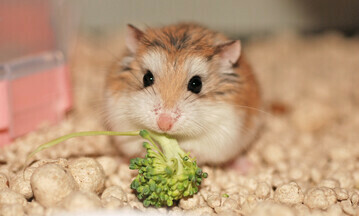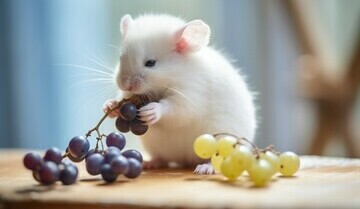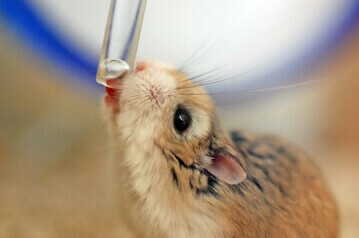If you want to ensure the well-being of your fuzzy little friend, understanding and catering to their dietary needs is crucial. A balanced hamsterdiet is the cornerstone of good health for hamsters, just as it is for any other pet or even us humans. But what exactly constitutes a ‘balanced’ diet for a hamster? You’re going to find out about the importance of a carefully calibrated diet to prevent obesity and malnutrition, which are common issues in these small rodents.
A hamster nutrition guide doesn’t just lay out a list of foods to eat. It gives insights into the specific nutritional requirements that these creatures need to thrive. Think high-quality pellets, a sprinkle of seeds, bits of fresh produce, and the occasional tasty protein – these are all parts of a healthy hamster menu. Hamsters have a penchant for hoarding food, so it’s our job to make sure that what they’re stashing away contributes positively to their health.
Navigating the plethora of commercial hamster foods can be a real challenge. That’s why I’m here to help you decipher the nutritional labels to pick the right products. Look for a mix of grains, seeds, and essential vitamins. And when it comes to protein, small amounts – whether from animal sources like cooked chicken or insect proteins such as dried mealworms – should be on your shopping list.
In my opinion, balance is key. You can’t just rely on a single type of food to keep your hamster healthy. And while seed mixes might seem like a one-stop-shop, they can often lead to selective eating habits and nutritional imbalances if they’re the only thing on the menu. For that reason, we’ll also talk about how to incorporate a variety of other foods into your hamster’s diet, ensuring they get all the nutrients they need without all the guesswork.

The Cornerstones of a Hamster’s Diet
While hamsters are often seen as easy pets, their dietary needs are more complex than filling a bowl with store-bought food. Your little buddy relies on you to provide the right kind of nutrients. I’m going to help you understand what makes up the cornerstone of a great hamster diet.
High-quality pellets should be at the top of your hamster food list. They’re formulated to offer a balanced range of nutrients, including grains, seeds, and essential vitamins. But don’t just grab any bag off the shelf. It’s vital to choose a pellet that’s tailored to hamster dietary needs. Believe me, it can make all the difference in their health and energy levels.
Next up, we’ve got fresh foods. Introducing fresh vegetables and fruits into your hamster’s diet isn’t just a luxury; it’s a requirement for balance. Small amounts of leafy greens like kale and spinach are excellent, but always in moderation to prevent digestive issues. Starchy veggies, like potatoes, should be a no-go, as they can do more harm than good. And remember, fresh water isn’t optional. Just as it is for us, water is crucial for hamsters, so ensure your furry pal has access to it at all times.
The topic of seed mixes can be a bit controversial. Yes, they might seem appealing and often get marketed as complete feeds, but here’s the deal: they can lead to selective eating, which means your hamster might only pick out the yummy, often less nutritious bits. Use them sparingly, and always as part of a balanced diet.
Speaking of balance, you might be wondering, ‘What about treats?’ Well, I’m glad you asked. Hamsters, like us, love a good treat. Small pieces of nuts and seeds can be great, but steer clear of treats laced with sugars and artificial colors. They’re no good for your hamster’s health.

Enriching Your Hamster’s Diet with Fresh Produce and Protein
So you’re thinking of mixing things up in your furry friend’s food bowl? Introducing fresh produce and protein into your hamster’s diet isn’t just a treat for their taste buds; it’s a critical component of their health. That’s where fresh veggies and protein come into play.
Let’s kick things off with fresh food. Hamsters can enjoy a variety of greens and vegetables. Leafy staples like kale and spinach should be on your shopping list, alongside toothsome root veggies like carrot slices and the occasional sweet potato nibble — remember, moderation is key. Other hamster-friendly veggies include broccoli, cucumber, and bell peppers. Steer clear of starchy or gas-inducing options, like potatoes, to prevent digestive issues.
Now, while fruits are a hit with hamsters, they’re akin to sugary desserts for us. They should be a once-in-a-while delight, not a regular feast. Safe bets include apple slices (seeds removed—they’re toxic!), banana bits, and a variety of berries. But keep portions small to avoid loading your hamster with excess sugar.
Protein is a must, but not all protein is created equal for these little guys. Offer bits of cooked chicken or scrambled egg sparingly; these should be treats, not main courses. Insect protein, like dried mealworms or crickets, is a hamster’s dream—you’re not just feeding them, you’re providing a feast fit for a furball king! These critters supply natural protein that’s hard for a hamster to pass up.
In the next section, we’re going to zero in on feeding tips that will have your hamster doing happy cartwheels (or, you know, running on their wheel). You’re going to find out about nifty ways to keep their mealtimes both exciting and health-promoting. Think of it as your personal playbook for a robust hamster diet strategy!

Feeding Tips for a Happy and Healthy Hamster
Now that you’ve got a solid understanding of how fresh produce and protein can elevate your hamster’s diet, it’s time to bring all these elements together with practical feeding tips. Choose something that resonates with you, yet is nutritionally complete for your furry friend.
Creating a varied menu from a curated hamster food list ensures your pet is getting the balance it needs. Every hamster has its unique likes and dislikes, but a tablespoon of high-quality commercial food combined with the fresh options discussed sets a solid foundation.
Monitoring your hamster’s water intake is just as critical as its food consumption. A consistent supply of fresh water through a sipper bottle or shallow dish, which should be replenished and cleaned daily, is quintessential for maintaining your hamster’s health.
Portion control is crucial – overfeeding can lead to health issues such as obesity and diabetes. Observing and adjusting your hamster’s diet based on activity level, weight, and overall health is key to a long and happy life.
Switching up the foods not only prevents boredom but also provides an opportunity to bond with your hamster as you discover which nutritious treats it prefers. Remember, introducing new foods should be done gradually to prevent digestive upset.
Lastly, your hamster’s health is a direct reflection of its diet, so take note of changes in weight or behavior. If in doubt, consult with a vet who’s knowledgeable about small animals to ensure your hamster is on the right track with its dietary plan.


2 replies on “How To Balance A Hamster’s Diet”
Hello!
A diet for hamsters? I can’t even properly do a diet myself haha.
It’s clear that you have a deep understanding of the dietary needs of these adorable creatures and are dedicated to ensuring their well-being.
While I may struggle to maintain a proper diet myself, your insights have inspired me to prioritize the health and happiness of my future hamster companions.
Thank you for sharing your expertise and spreading the joy of hamster care!
Hello Cortes,
Ensuring your hamster has a balanced diet is indeed essential for their health and happiness. While it might seem challenging at first, once you know the basics, providing a nutritious diet for your hamster is quite manageable. Here’s a simple guide to help you out:
High-Quality Hamster Food: Start with a high-quality commercial hamster food mix. These mixes typically contain a variety of seeds, grains, and pellets, providing a good balance of nutrients. Look for brands that list protein sources like soybean or animal proteins and avoid those with excessive sugary treats.
Fresh Vegetables: Supplement their diet with fresh vegetables a few times a week. Safe options include carrots, broccoli, cucumber, bell peppers, and spinach. Introduce new vegetables gradually to avoid digestive upset and always wash them thoroughly.
Fruits: Offer small amounts of fruit as an occasional treat. Suitable fruits include apples (without seeds), strawberries, blueberries, and bananas. Due to their high sugar content, fruit should be given sparingly.
Protein Sources: Hamsters also need protein in their diet. Provide small amounts of boiled eggs, mealworms, or plain cooked chicken once or twice a week.
Healthy Treats: Occasionally, you can give your hamster small treats like plain, unsweetened cereals, whole grain pasta, or millet. Avoid sugary or fatty human foods.
Fresh Water: Always ensure your hamster has access to fresh, clean water. Check and refill their water bottle daily.
Avoid Toxic Foods: Some foods are harmful to hamsters and should be avoided, including chocolate, caffeine, alcohol, onions, garlic, and citrus fruits.
By following these guidelines, you can provide a balanced and varied diet for your hamster, ensuring they stay healthy and happy. Remember, every hamster is unique, so observe your pet and adjust their diet as needed. Your dedication to their well-being is sure to make a positive difference!
Some of these tips we can also apply to ourselves ofcourse 😉